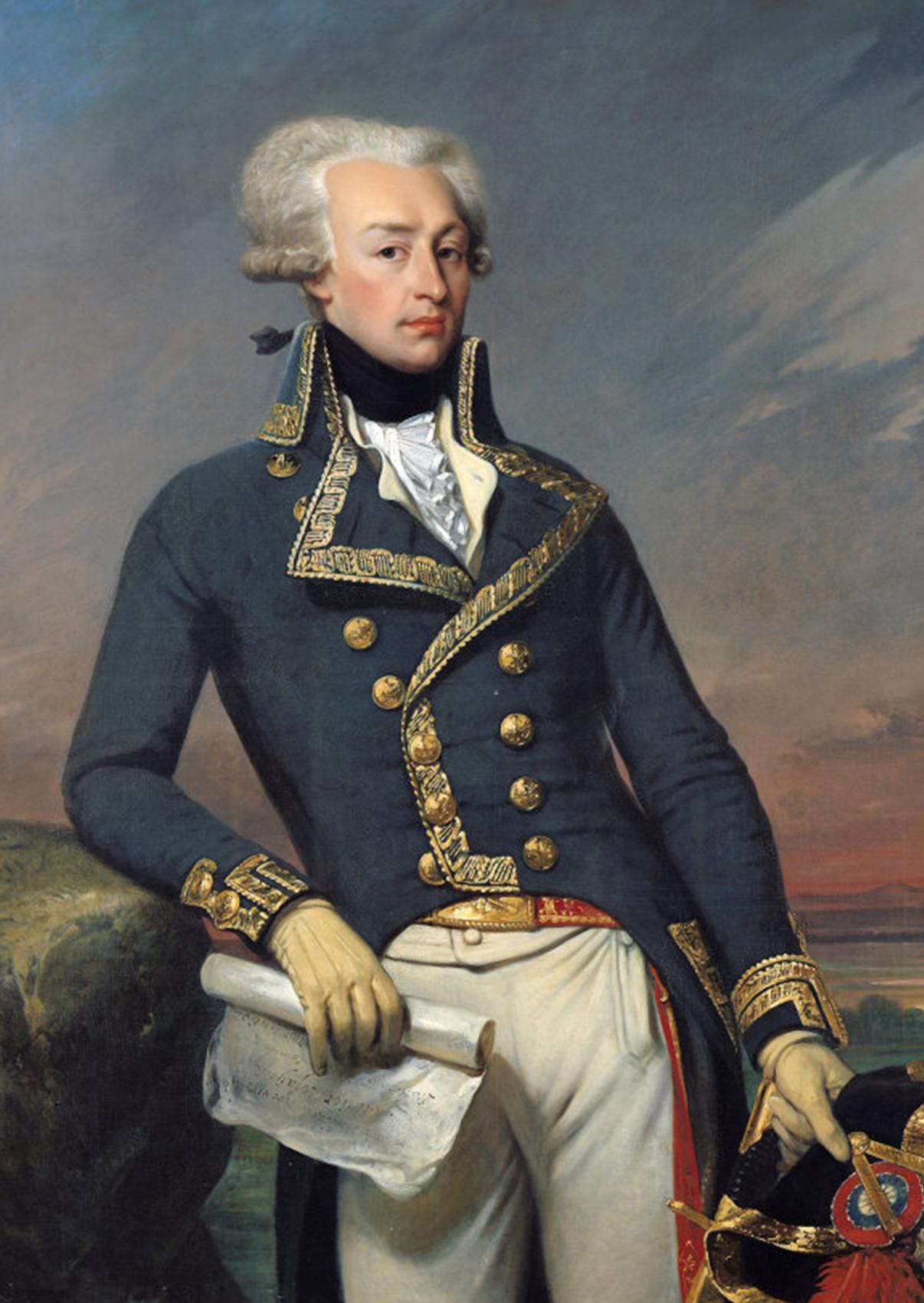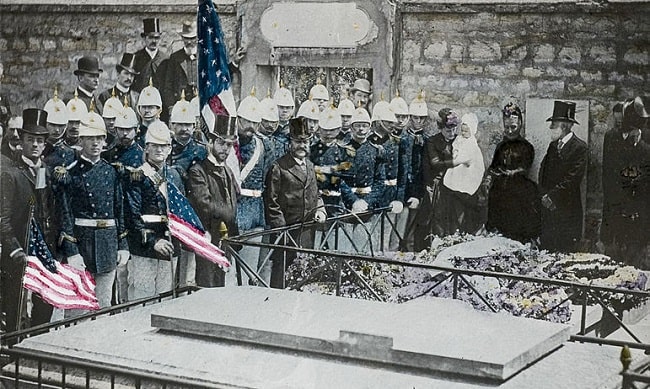Lafayette: A Lasting Franco-American Friendship


- SUBSCRIBE
- ALREADY SUBSCRIBED?
BECOME A BONJOUR PARIS MEMBER
Gain full access to our collection of over 5,000 articles and bring the City of Light into your life. Just 80 USD per year.
Find out why you should become a member here.
Sign in
Fill in your credentials below.
Rupert Brooke, the English World War I poet, imagined a “corner of a foreign field” which would be “forever England” should an English soldier killed in battle be buried there. Did you know that there’s a corner of a former Paris convent garden which will always be inextricably linked to the United States of America? For when Gilbert du Motier, better known as the Marquis de Lafayette, was laid to rest in the Picpus Cemetery (12th arrondissement) in 1834, he had requested that soil he had personally brought back to France from Bunker Hill, near Boston in Massachusetts be sprinkled on his coffin.
The American flag flies permanently over the grave, refreshed every year in a moving ceremony organized by the American Friends of Lafayette. They ensure that the memory of this French aristocrat, who fought under George Washington in the American War of Independence, lives on in the U.S. and this year they are commemorating something very specific. It is now exactly 200 years since a grateful President James Monroe decided to mark the new nation’s approaching 50th anniversary by inviting Lafayette back to America to make a grand tour of the country. Between August 1824 and September 1825, Lafayette travelled 6,000 miles and was feted in many towns all along the route.

American flag at Lafayette’s grave in Paris. Photo: Marian Jones
Lafayette’s American story is remarkable. A wealthy young aristocrat, he left the court of Louis XVI in 1777, aged just 19, and sailed to America to offer his services to George Washington in the fight for independence from the British. He soon won Washington’s admiration and was given command of a division, then returned to France to lobby for more French troops and supplies to boost Washington’s cause. These, along with Lafayette’s distinguished command of an army in Virginia, especially during the Siege of Yorktown in July 1781, proved decisive in the British surrender. Lafayette then returned to France, where he became a crucial figure both during and after the revolution. However, his American friends never forgot their debt of gratitude to him.
And so, in 1824, as America’s 50th anniversary neared, Lafayette was invited back to the country in whose founding story he had played so crucial a part. It was really quite a celebration. For 13 months, beginning in August 1824, Lafayette traveled the country, by stagecoach, on horseback, on canal boats and steamers, visiting all 24 states then in existence and stopping off in many towns and cities where thousands gathered to greet him. Some cities held parades, others staged artillery salutes or celebratory dinners, monuments were erected in Lafayette’s honour and annual Lafayette Days were planned for the future. War veterans turned out in force to greet him and groups of schoolchildren were brought along to learn their history and meet the returning hero.

Lafayette as a lieutenant general, in 1791. Portrait by Joseph-Désiré Court. Public Domain.
A number of the Founding Fathers were among those who welcomed him, including President James Monroe who received him at the White House in Washington D.C. where the Lafayette Park named after him still exists. Lafayette’s visit to Monticello in Virginia was particularly poignant, for waiting on his porch to greet his old friend was Thomas Jefferson, then 81, who had been the 3rd American President from 1801-1809. Jefferson’s grandson later described the moment the elderly man descended the steps of his house to greet his guest: “As they approached each other, their uncertain gait quickened itself into a shuffling run, and, exclaiming, ‘Ah Jefferson!’ ‘Ah Lafayette!’, they burst into tears as they fell into each other’s arms.”

An illustration of the Marquis de Lafayette first meeting George Washington on 5 August 1777 by Currier and Ives. Public domain
The hundreds of events planned for this year’s Bicentennial of Lafayette’s Final Tour will trace Lafayette’s footsteps on the exact dates and in the exact order he followed on his tour. They will kick off with a dinner on August 15th on Staten Island, where Lafayette first arrived back in America, followed by a four-day extravaganza in New York City, attended by French and American dignitaries, including three of Lafayette’s descendants who will travel over from France. Then events will unfold all along Lafayette’s original route, a multitude of exhibitions, talks, and events as varied as a Lafayette Holiday Tea in Annapolis, Maryland, and an appearance by “our old friend and Revolutionary War hero Major General Lafayette” presiding over a re-enactment in Yorktown, Virginia.

Gloves portraying Lafayette, possibly commemorating his visit to the United States in 1824. Metropolitan Museum of Art.
Lafayette returned to France in 1782 and played a leading role in the revolution which was unfolding. As Marie-Joseph Paul Yves Roch Gilbert du Motier de La Fayette, Marquis de La Fayette, he was undoubtedly an aristocrat and close to the royal family. Nevertheless, he also had both liberal and republican instincts, supporting the abolition of slavery and the idea of Louis XVI becoming a constitutional monarch. As a member of the newly founded Assemblée Nationale, he drafted – with the help of Thomas Jefferson – the Declaration of the Rights of Man and of the Citizen, which was adopted in August 1789. It was a key document in the French revolution and became a cornerstone of western liberal democracy.
However, Lafayette was continually conflicted during this turbulent period. He had been appointed commander of the National Guard and it was his troops who had to deal with the mob riots at Versailles in October 1789. They first protected the king and queen from harm, then escorted them into central Paris where they were kept under guard at the Tuileries Palace. Similarly, although he supported some measures which transferred power from the aristocracy, he ordered his troops to open fire on rioters demanding the king’s abdication in 1791. Some 50 people were killed and Lafayette resigned. Under Robespierre’s Terror, Lafayette’s attempts to maintain order put his life in danger and he decided to flee to the U.S., but was captured and imprisoned in Austria for nearly five years.

Early 19th century depiction of Lafayette’s prison reunion with his wife and daughters. Henne, Eberhard Siegfried, engraver. Public Domain
Eventually freed by Napoleon, Lafayette returned to France and spent his last 30 years negotiating his way through France’s turbulent politics. He refused to serve in Napoleon’s government, but became a liberal member of the Chambre des Députés in 1815. In 1830, he declined the opportunity to lead a military coup, preferring instead to support the installation of Louis-Philippe as “citizen king.” Perhaps this explains why today he is more feted in America than in France. His support for American independence had been unequivocal, but in his native country he had to steer a nuanced path through 50 years of unprecedented political unrest.

Mort du général Lafayette by Gondelfinger, 1834. BnF. Public domain
When Lafayette died in 1834, there was only one place he wanted to be buried: in the Picpus cemetery in Paris, next to the love of his life, his wife Adrienne, the mother of his son Georges Washington de Lafayette. She had died in 1807, aged only 48, and had been buried at Picpus alongside her mother and sister who, as aristocrats, had been executed at the nearby Place du Trône Renversé (now Place de la Nation). Their bodies were thrown into a mass grave in the garden of a former convent, confiscated for this macabre purpose by the revolutionary government. Relatives of the victims later bought the site to keep it as a place of remembrance and decreed that anyone related to those executed had the right to be buried there.
The other Parisian site where Lafayette is remembered is the Cours de la Reine, a walkway along the right bank of the Seine, near the Alexandre III Bridge, where an imposing statue depicts him sitting astride his horse, his sword aloft, ready for action. The statue, America’s response to France’s gift of the Statue of Liberty, was erected in 1908 in the courtyard of the Louvre, then moved to its present site in 1988. It’s the work of the American sculptor, Paul Wayland Bartlett, paid for by donations from 5 million American schoolchildren. The inscription, carved in both French and English, summarizes the reasons why so many Americans admire him: “Erected by the school children of the United States, in grateful memory of Lafayette, statesman, soldier, patriot”.

US Marines decorating grave of Lafayette, Picpus Cemetery, Paris 1889. Image © Wikimedia, CC BY 2.0
Lafayette is remembered in the U.S. as someone who played a key role in the War of Independence and the subsequent founding of the American Nation. He was granted honorary American citizenship and today there are more than 30 towns and cities named after him – Faytteville in North Carolina and Lafayette in Louisiana, for example. There are monuments and statues to him throughout the country, many of which will feature in the Bicentennial of Lafayette’s Final Tour celebrations.
A moment in 1917, more than 80 years after Lafayette’s death, perfectly illustrates the bond he represents between France and America. In July that year, just three months after America had entered World War I in support of France and her allies, U.S. Army Colonel Charles E Stanton visited Lafayette’s grave in the Picpus Cemetery and planted the flag of the USA. His words perfectly captured the loyalty between the two countries which Lafayette had done so much to promote and which continued long after his death: “America has joined forces with the Allied Powers, and what we have of blood and treasure are yours ….. Here and now, in the presence of the illustrious dead, we pledge our hearts and our honor in carrying this war to a successful issue. Lafayette, we are here.”
More Information
Bicentennial of Lafayette’s Final Tour: program of events
The American Friends of Lafayette.
This 80 year-old organization is currently having a membership drive, aiming to boost numbers to the highly significant total of (at least!) 1776 by the equally significant date of 2026, the 250th anniversary of the signing of the American Declaration of Independence.
Their stated mission is ‘To educate about the life and legacy of Lafayette, to celebrate the Franco-American Alliance and to enrich public knowledge though meaningful programming and remembrances.”

Lafayette statue in the Cours de la Reine, Paris. Photo: Marian Jones
Lead photo credit : Lafayette statue in the Cours de la Reine, Paris. Photo: Marian Jones
More in history, Lafayette, People


